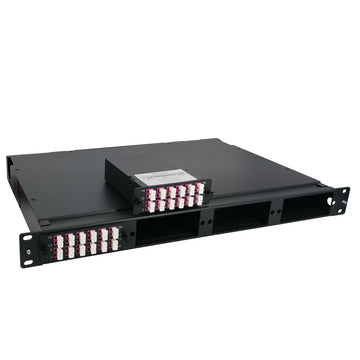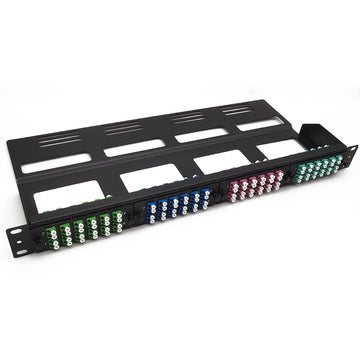What Is CEx WDM (Coexistence Coexistence Wavelength Division)
What Is CEx WDM (Coexistence Coexistence Wavelength Division)
CEx WDM (Coexistence WDM). Why is it named "Coexistence" WDM? The author will take you to explore its origin. First, let's take a look at Passive Optical Networks (PON).
Passive Optical Network (PON) is a technology for information transmission using a point-to-multipoint tree-shaped optical fiber distribution network. The point-to-multipoint physical topology is especially suitable for wired access network scenarios. A PON system generally consists of an OLT device located at the central office, an ONU device located at the user side, and a passive optical distribution network connecting the two.
In the PON system, since multiple ONU devices share the same optical fiber medium to communicate with the OLT, it is mainly necessary to solve the problem of medium sharing among different ONUs. The main ways to solve the media sharing in optical fiber include time division multiplexing/multiple access technology, wavelength division multiplexing technology and orthogonal frequency division multiplexing (OFDM) technology. Therefore, the main PON technologies can also be divided into three categories: TDM-PON, WDM-PON and OFDM-PON.
Development and evolution of PON (Passive Optical Network) technology:
| Time | Technical characteristics | |
| Early stage | Narrowband PON | |
| The earliest PON system is mainly used to solve the interconnection of multiple narrowband access networks (digital subscriber loops) remote devices, and transmit NX64kbit/s voice time slots. | ||
| 20th Century the 90s |
BPON | |
| In 1998, the standard "Broadband Optical Access System Based on Passive Network (PON)" (TTU-TG.983.1) was issued by FSAN and ITU-T. BPON adopted the design idea of ATM as the core in the technical environment at that time. . But limited by the factors of device level and price at that time, the cost of PON equipment is still relatively high. | ||
| 2000-2004 | EPON | GPON |
| Organization: IEEE Standard: IEEE 802.3ah |
Organization: ITU-T Standard: G.984.1~G.984.6 six standards |
|
| ①Using optical fiber bidirectional transmission ②Operating wavelength: upstream wavelength 1310nm; downstream wavelength 1490nm ③Effective broadband 800-950Mbit/s ④ Optical transceiver index: 10km (PX10); 20km (PX20) ⑤ In practical applications, PX20 is mostly used to achieve a transmission distance of 20km and a split ratio of 1*32. |
①Using single-fiber dual-line transmission ②Operating wavelength: upstream wavelength 1310nm; downstream wavelength 1490nm ③Effective broadband: downlink 2.45Gbit/s; uplink 1.1Gbit/s ④Adopt 125us fixed frame length, downlink rate: 2.488Gbit/s; ⑤Can achieve 20km transmission distance and 1*64 split ratio |
|
| 2006-2008 | 10G-EPON | XG-PON |
| Organization: IEEE Standard: IEEE 802.3av |
Organization: ITU-T Standard: G.987, G.988 |
|
| ①Using single fiber bidirectional transmission ②Operating wavelength: Upstream wavelength: 1260-1280nm; Downstream wavelength: 1575-1580nm ③ Divided into 2 types: First, asymmetric mode: downlink rate: 10Gbit/s; uplink rate: 1Gbit/s Second, symmetrical mode: downlink rate: 10Gbit/s; uplink rate: 10Gbit/s (easy to implement in asymmetric way) Downstream direction: use WDM method for wavelength isolation with 1490nm EPON Upstream direction: Since the laser spectrum used by the ONU of EPON is wider (1310+50nm), it overlaps with the wavelength of 1260-1280nm. Therefore, when the ONUs of EPON and 10G-EPON coexist in the same ODN, the TDMA method must be adopted, and the two cannot be transmitted at the same time. |
①Using single fiber bidirectional transmission ②Operating wavelength: Upstream wavelength: 1260-1280nm; Downstream wavelength: 1575-1580nm ③Asymmetric mode: Downlink rate: 10Gbit/s; Uplink rate: 2.5Gbit/s Downstream direction: use WDM method for wavelength isolation with 1490nm GPON Upstream direction: The ONUs of GPON and XG-PON can use wavelength isolation, and the two do not affect each other |
|
| 2010-2015 | NG-PON2(XGS-PON) | |
| Organization: ITU-T Standard: G.989 ①The downlink rate is at least 40Gbit/s, and the uplink rate is at least 10Gbit/s ②The maximum transmission distance and maximum differential distance are 40km ③Maximum support 1:256 split ratio ④Contain at least 4 TWDM channels ⑤Use colorless ONU |
||
From the above, we can see that PON technology is gradually developing. But we can not abandon the original system, the cost is too great. So how do we realize the coexistence of multiple PON systems and allow them to be upgraded smoothly? In order to share the G/EPON with the NG-PON1 and NG-PON2 systems, it is necessary to use the CEx wavelength coexistence original, also known as Coexistence WDM (coexistence wavelength division).
The Coexistence Element (CEx) of xWDM/xPON multiplexer is a single WDM device to combine current G-PON FTTH services with emerging XGS-PON and Next Generation NG-PON2 technologies. Additional provisioning wavelengths with the Coexistence Element include RF, Point to Point (PtP), and OTDRmonitoring.Its compliant with ITU-T G.984.5. High quality components ensure very high operation stability of xWDM/xPON multiplexers in the wholespectral range and perfect thermal stability. Heyoptics offers a flexible platform of Coexistence Element productsto fit a specific PON deployment that is most cost-effective to your needs – Depending on your requirementseach CEx can be fully complemented with all PON services or with only the services requested. Premiumoptical components and high-quality connectivity ensure superior performance, the lowest loss, androbust network reliability.
APPLICATIONS
- WDM systems
- PON SYSTEM
- FTTH access networks
- optical telecommunication networks
LightOptics focuses on the R&D, manufacturing and production of passive components for optical communication. With strong R&D capabilities and rapid response delivery capabilities, LightOptics can provide customers with a full range of wavelength division multiplexing products, such as Cex WDM modules for PON coexistence, 5G MWDM , DWDM, AAWG, CWDM, CCWDM, etc.













